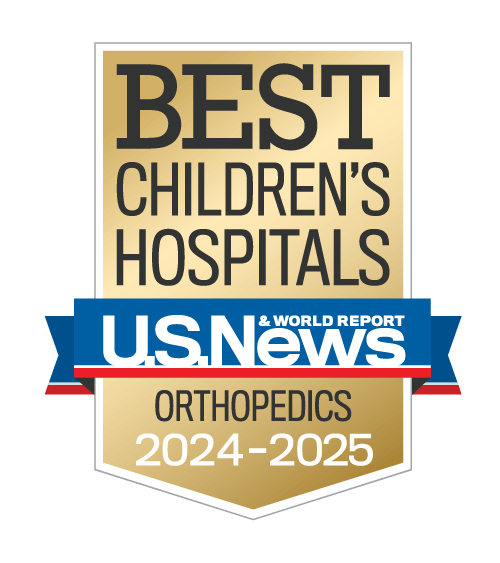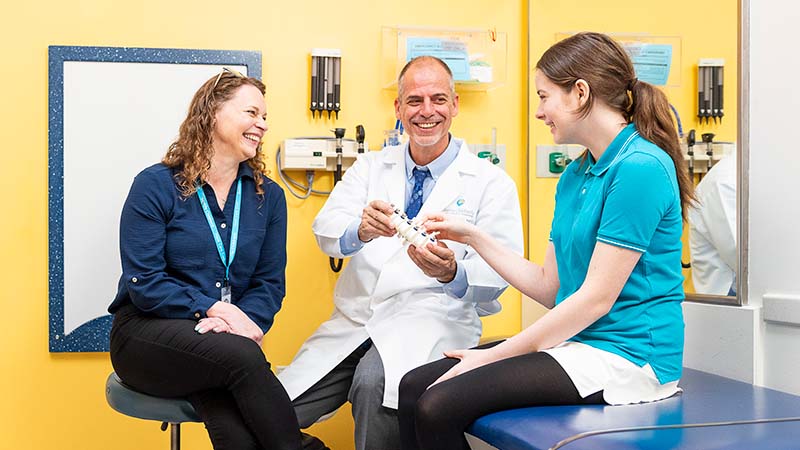Torticollis
What is torticollis?
Torticollis is a twisted and tilted neck. It can come on for a short while and go away again. It can also be present at birth (congenital).
What causes torticollis in children?
Muscular torticollis is the most common type. It happens if your child’s neck muscles are especially tight on 1 side or if something has caused scarring on 1 side of the neck. The tight muscles or scarring can cause your child’s head to tilt to 1 side.
Congenital muscular torticollis means a baby is born with this condition. It happens more often if babies are crowded while in the womb. It usually gets better in the first year after birth. can help by stretching neck muscles.
Fixed torticollis means the neck twist or tilt is permanent, usually because of a problem with bones or muscles. For example, a baby’s neck bones (vertebrae) or skull may not have formed in the usual way. This can cause a twist or tilt for any of these reasons:
- Their head and neck are less stable than is typical.
- The space inside their neck vertebrae is too narrow (stenosis).
- The top of their spine presses into the bottom of their skull (basilar invagination).
- Their neck vertebrae are not the typical shape.
- Some of their neck vertebrae are joined (as in Klippel-Feil syndrome).
Fixed torticollis can also happen in children with a condition, like , where their muscles might spasm in a tight position.
In some children with fixed torticollis, the face may look unbalanced or flattened (plagiocephaly). Children may also have mild delays in developing use of their muscles (motor skills).
After birth, a child might develop short-term torticollis if an illness, infection (like an ) or injury makes their neck muscles spasm. For most children, this goes away after a day or 2. All your child may need is some rest and gentle activity. Your child may also need medicines to treat the cause, like a . Light traction (a way to carefully pull on the head to make space in the neck) may also help. Your child’s care team can do this at a clinic visit and show you how to do it safely at home.
Temporary torticollis can also happen if:
- Your child’s are hot and swollen (inflamed) after they have had an ear infection or a cold.
- Your child hurts their head or neck. The between the bones in the neck can swell and become sore.
- Your child has an imbalance or other problem with their eye muscles, so they tilt their head in order to see straight.
- Stomach acids get into the tube that connects your child’s mouth to their stomach (esophagus). This can cause spasms that change how your child holds their head, neck and back (Sandifer syndrome).
Spine Program at Seattle Children's
What are the symptoms of torticollis?
Children with torticollis have a stiff neck and cannot move their necks very much. They hold their heads to 1 side. Their chins might point up a little bit.
Different types of torticollis may have other symptoms too.
How is torticollis diagnosed?
When you and your child come to our clinic, our doctors ask you questions about how your child has been developing. Doctors examine your child. The exam will likely include an evaluation of the and an eye test.
We may take and ask for an scan of your child’s and . This is more likely if your child has had developmental delays or if their neck is moderately or severely twisted and the doctor can find no reason for it.
How is torticollis treated?
We offer a full range of treatments for different types of torticollis and the problems that may come along with them, including facial imbalance (asymmetry).
In about 90% of babies, muscular torticollis improves during the first year of life. The condition may improve faster if your baby gets physical therapy to stretch their neck muscles.
Surgery for torticollis
It is rare for a child to need surgery for torticollis.
If your child’s condition does not get better with nonsurgical treatments, like physical therapy, the team in our Spine Program offers surgical treatment. This includes procedures to:
- Lengthen or release neck muscles
- Fuse vertebrae that are not typical
- Apply a device, like a neck brace (cervical collar), that holds the neck in a new position for a while
Why choose Seattle Children’s for torticollis treatment?
 Experts in Orthopedics and Sports Medicine, including our Spine Program, treat all kinds of neck problems in children. Ours is the largest pediatric spine center in the Pacific Northwest.
Experts in Orthopedics and Sports Medicine, including our Spine Program, treat all kinds of neck problems in children. Ours is the largest pediatric spine center in the Pacific Northwest.
We offer the most comprehensive care for your child, no matter how complex their condition is. It’s why other hospitals in the region refer their most complex pediatric patients to us.
-
The experts you need are here
- Based on your child’s needs, their team includes doctors, surgeons, , and others from Orthopedics and Sports Medicine, the Craniofacial Center, Ophthalmology and Physical Therapy. They work together to understand and treat your child’s condition.
- We can successfully treat torticollis in most children without surgery. Often, this means rest, medicine or physical therapy. We have the largest team of in the Pacific Northwest who specialize in the care of babies, children, teens and young adults.
- If your child does need surgery, our orthopedic spine surgeons are leaders in their field. They have more training and experience with children’s complex spine conditions than anyone else in the area. Spine surgery for children is all they do. Each is .
- Torticollis and the health problems that can cause it may affect more than the bones, muscles and joints in a child’s neck. That’s why we connect you and your family with any expert your child may need across Seattle Children’s. For example, we may involve the team from the Neuromuscular Program.
-
Our approach to surgery increases comfort and reduces stress
- Our new state-of-the-art operating rooms reduce stress and increase comfort for your child. The design lets you stay by your child’s side until they gently go to sleep before any spine surgery.
- Few children need surgery for torticollis. Before we recommend surgery, we look at your child as a whole person. Your child’s team will take many factors into account. These include how serious their condition is, the effects on their health and how much more they will grow. We also consider what results you can expect from treatment.
- If your child needs surgery to fuse neck vertebrae, our orthopedic surgeons and neurosurgeons work together to make the procedure as safe as possible for your child.
- We have the technology and skills to use 3D imaging to guide your child’s surgery, if needed. This helps us operate with precision. It also lets us see in real time the changes we make to your child’s spine. Based on your child’s needs, we may use or .
- We have a dedicated spine anesthesia team. They specialize in keeping children safe and comfortable during spine surgery.
- helps us prevent a spinal cord injury during surgery. Our surgical spinal cord monitoring team leads the country in new ways to make back surgery safer.
-
Neck care from birth through young adulthood
- We specialize in caring for kids. This means our experts have the knowledge, training and skills to treat the youngest patients through young adults. We have treated many children with torticollis. At Seattle Children’s, your child’s team has special training in the physical, emotional and social needs of young people.
- Babies, children and teens are still developing, so they may need different care than adults do. When we evaluate your child’s condition, design their treatment and provide their care, we carefully consider their growth. We think about how growth may affect your child’s neck over time. We also consider how their neck problem may affect the rest of their development and health.
- If your child needs imaging that uses radiation, we use the lowest amount possible (PDF) to make the best image. We also have the largest group of pediatric radiologists in the Northwest.
-
Support for your whole family
- We know it can be stressful to have a child with a neck problem and to find the treatment they need. Everyone at Seattle Children’s works to make your experience here as easy as we can on your whole family.
- Your child’s team does more than plan and provide care for your child. We also make sure you and your child understand your child’s condition and treatment options.
- Care is easier for you because your child’s team members work closely with each other — and with other programs and clinics your child may need at Seattle Children’s.
- Seattle Children’s supports your family with a range of resources. Our Child Life specialists, Family Resource Center and Guest Services are here to help.
-
Research to improve care
- Members of the Spine Program team are leaders in research. We are always tracking the results of our patients’ care so we can be sure we are choosing the best treatment for each child. Your child’s care team may ask if you want to be involved in research. For example, we may ask to include data about your child’s condition and treatment in our studies.
- Our spine experts are part of national and international research groups. These groups study the latest treatment approaches and technologies. Together, we work to find the best and safest ways to care for children. We are part of the Pediatric Spine Study Group, Harms Study Group and Fox Congenital Spine Study Group.
- Learn more about current orthopedics research at Seattle Children’s.
Contact Us
Contact Orthopedics and Sports Medicine at 206-987-2109 for an appointment, a second opinion or more information.
Providers, see how to refer a patient.
Related Links
Paying for Care
Learn about paying for care at Seattle Children’s, including insurance coverage, billing and financial assistance.


